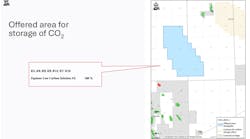Towed streamer system expands technology's application range
Joshua May
PGS
In the current low oil price environment, oil companies are increasingly focused on acquiring higher quality subsurface data faster and more cost effectively. One can question what “cost-effective” really means when it comes to improving the chances of discovering commercial volumes of hydrocarbons. Is it paying the lowest price for a commoditized service, or is it more accurately described as extracting and integrating every bit of subsurface information within the limitations of the available exploration budget?
Maximizing value for money means employing the correct technology in the appropriate environment and thereby improving chances of success.
Exploration managers must be confident that geophysical technologies will provide extra subsurface information that will have a material impact on licensing, exploration, and drilling decisions. To this end,PGS conducts 3D controlled-source electromagnetic (CSEM) feasibility studies prior to acquisition, which provide oil companies with an understanding of how towed streamer EM can assist in solving a particular geophysical challenge.
For example, a large-scale 3D towed streamer EM campaign, strongly supported by industry, was acquired during 2014-15. This data has been used by companies during various stages ofNorway’s 23rd licensing round, the results of which were announced in May, with 10 new production licenses awarded to 13 companies. Further evidence of the increasing value attached to EM technology can be seen in the 2016 Awards in Predefined Areas round: 10 of the licenses offered included some reference to EM in their work programs compared to one in 2012 and none in both 2013 and 2014. Thus, 3D multi-client EM data has assisted oil companies in decision-making prior to and during recent license rounds offshore Norway.
The maximum value of CSEM data is extracted when interpreted and integrated with seismic and other geophysical information. From a simple co-rendering of seismic and resistivity data, to seismically guided inversion, and even reservoir level workflows such as estimating hydrocarbon saturation and hydrocarbon volumes in place, towed streamer EM data significantly improves subsurface understanding prior to investment decisions being made. This improved understanding can provide oil companies with a competitive advantage when it comes to bidding on acreage, drilling exploration wells, and even optimizing field development and production. Further, EM can provide improved confidence in how exploration and production budgets are utilized, ensuring maximum value is extracted from every dollar spent.
PGS has invested in multi-client EM data in the Barents Sea for the last three years, assisting major oil companies in their bidding and drilling decisions by providing the aforementioned advantage not available to those with seismic data alone. This investment is not only to the benefit of industry, but also those responsible for regulation, permitting, and resource management on a national scale.
There is another aspect of complementarity over and above seismic and resistivity integration: simultaneous acquisition of towed streamer EM and 2D GeoStreamer broadband seismic, as is shown in the related schematic.
In addition to offering an integrated simultaneous acquisition of CSEM and seismic data, an EM-only acquisition service is also available. Given that, to extract maximum value from resistivity data it should be interpreted with seismic and other geophysical information. This EM-only acquisition is employed in areas of existing seismic, usually 3D. During the 2014 EM campaign in the Barents Sea, a record acquisition rate of more than 200 sq km (77 sq mi) in 24 hours was set by the crew. These high rates of acquisition were enabled by towing the EM streamer at 4-5 knots and acquiring full high-density 3D CSEM data with a 1 km (0.6 mi) sail line spacing.
The standard EM streamer is 8,700 m (28,543 ft) long with an 800 m (2,624 ft) EM source. The equipment is configurable; it can be extended to 10,000 m and 1,200 m (32,808 ft and 3,937 ft), respectively, in the event that deeper subsurface imaging is the priority. Conversely, should the aim of the survey be, for example, imaging shallow gas in the overburden of a production field, EM streamer length can be reduced to minimize operational risk during close passes. The EM streamer is towed at a depth of up to 100 m (328 ft). This can be reduced in shallow-water areas, as in the case of the 2013 Celtic Sea survey. This was acquired with the EM streamer at 50 m (164 ft) and the broadband marine seismic system at 25 m (82 ft).
It should be noted that in contrast to streamer seismic, both 2D and 3D towed streamer EM projects are acquired with a single EM streamer. Line spacing of less than 1.5 km (0.9 mi) allows for anisotropic inversion of both 2D resistivity sections (one per sail line) as well as a 3D resistivity volume. Projects with a line spacing of more than 1.5 km (0.9 mi) are considered 2D with resistivity sections generated from 2.5D inversion.
The EM streamer has 72 offset pairs, ranging in length from 200 m (656 ft) at the near offset to 1,100 m (3,608 ft) at the far offset. This provides exceptionally dense resistivity data which is rich in both offsets and frequencies. This dataset enables optimization of data selection for inversion. These parameters can be evaluated during the feasibility study phase of a project, ensuring selection of the frequencies and offsets which will be most useful to image the target in question. It is this density of data which provides improved resolution in resistivity profiles and volumes and enables detailed reservoir level quality improvement workflows to be applied.
Simultaneously towed streamer EM and GeoStreamer acquisition provides additional benefits on top of the cost savings and improved resolution of resistivity data discussed. HSEQ exposure is reduced, as both datasets are acquired using a single vessel, less fuel is consumed, and fewer vessel days are required compared to acquiring two separate surveys. Operationally, the addition of EM to a 2D broadband marine seismic survey requires minimal extra personnel; the equipment is deployed and operated by a standard seismic crew with the addition of one or two EM specialist field engineers.
EM technology has traditionally been used as a de-risking tool, in part due to the diffusive nature of the technique resulting in relatively low resolution when compared to seismic. However, with the advent of towed streamer EM and associated high-density data, more focused, high-resolution applications have become viable. By integrating seismic and resistivity data, the ability to estimate hydrocarbon saturation can be applied in mitigating drilling hazards as well as field development optimization. It has the additional potential to be applied in a 4D sense, in appropriate environments.
Near-field exploration is of particular interest at present, as highlighted in the article “Brownfields: making the most of mature fields,” which appeared in the May 2016 issue of Offshore. If survey design is optimized through a project specific feasibility study, the towed streamer EM data acquired to investigate potential drilling hazards can also be used to investigate the near field potential. With the integration of seismic, resistivity, and well log data reservoir characterization and QI workflows have been developed, enabling the estimation of hydrocarbon volumes in place.
PGS’ towed streamer EM system resulted in a step change in CSEM acquisition efficiency, in conjunction with dramatically improved sampling density. This advance has expanded the technology’s application from frontier exploration to more detailed reservoir imaging and characterization.
Acknowledgement
PGS wishes to acknowledge the assistance of the International Association of Geophysical Contractors in the development of this article.






